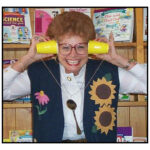
by: Janice VanCleave
As a teacher, I enjoyed having people visit my class. It brought out the “ham” in me and I did and said things that even surprised me. Rubbing a balloon on my hair and making my hair stand on ends was not unusual, but climbing on top of my desk sticking the charged balloon to the ceiling was a bit over the top.
What I disliked was the unscheduled visitor with an evaluation sheet in hand. But, I was always prepared. In fact, I had a box filled with materials for fun engaging activities. It was my “Emergency Experiment Box.” When the evaluator unexpectedly arrived, out came the box and the show began.
My teaching abilities were being evaluated during an unexpected visit, so I was prepared to show all my best qualities. I suggest you have an Emergency Experiment Box, and I do recommend including the Energy Ball.
Whatever you put in your box, make sure you know as much about the experiment as possible. The Energy Ball is great for teaching the scientific method. Too often kids memorize the steps of the scientific method, but do not use them on a daily bases. The scientific method is a set of problem solving tools—but every problem does not require using every instrument in the tool box.
I regress, let me get back to using the Energy Ball to fire up your students with or without unexpected guests.
Research: Collecting information.
Use the Energy Ball to show students that research is any method used to collect information.
1. Demonstrate “Turning On” the Energy Ball by touching the metal terminals on the outside of the ball with your thumb and forefinger of one hand. The ball flashes a red light and buzzes.
You might receive a positive note on your evaluation about your WOW! Factor.
 2. Show the metal strips on the ball and explain that to “Turn On” the ball, something has to bridge the gap between the metal strips. This something has to allow electric energy to flow through it. Point out that things that allow electric energy to flow them are called conductors. Things that do not allow electric current to flow through them are called insulators.
2. Show the metal strips on the ball and explain that to “Turn On” the ball, something has to bridge the gap between the metal strips. This something has to allow electric energy to flow through it. Point out that things that allow electric energy to flow them are called conductors. Things that do not allow electric current to flow through them are called insulators.
Question: What can be used to bridge the gap between the metal strips and close the electric circuit?
Hypotheses:
You want the kids to do more than provide a list of conductors. Instead, guide them so they learn to express hypotheses. No, hypotheses are not always needed, but they do encourage kids to pull facts from past experiences in order to make informed predictions.
Remind students that a hypothesis is what they think the answer to the question is. It is not a wild guess, but an idea based on what they already know about the Energy Ball. Give an example hypothesis, such as:
If the human body is a conductor, then a long chain of people might be used to bridge the gap, closing the circuit.
Encourage kids to volunteer hypotheses by giving them clues. Ask, “What other things conduct electricity?” or ” What material could close the gap between the metal strips so electric energy flows?”
You have primed the kids and they should be ready to make you proud with their incredible hypotheses.
Of course, you can always count on at least one student to give an answer received from some space ship. Don’t let this throw you off track. Keep that smile on your face, and applaud such an innovative idea. Explain that you want to test each hypothesis, but at this time you don’t have metal samples from their intergalactic space ship.
Quickly ask a student you can depend on for another hypothesis. With the supplies from your emergency box the hypothesis can be tested on the spot. YEA!! The evaluator will be thrilled that you are so prepared.
Now is the time to really engage the students as well as the evaluator. Test your original hypothesis:
If the human body is a conductor, then a long chain of people should be used to bridge the gap, closing the circuit.
With you and your students holding hands in a circle, break the circle and invite your visitor to join in.
Ask the student next to you to touch one of the terminals on the Energy Ball while you touch the other terminal. There is a gap between you and the visitor.
This is an example of an open circuit. Ask what needs to be done to complete the circuit. The answer will be for you to hold hands with the visitor. But that would be too simple.
 Seize the moment. Have some fun and ask if a connection could be made if you touched the visitor’s nose with your finger. Of course it would. But then suggest the visitor touch your nose or your ear. If it doesn’t work, first asks if your little scamps are connected. Kids like to have a bit of fun with the teacher. Also, dry skin can inhibit the flow of electric energy. Moisten your finger with a damp paper towel (of course you have the paper towel and water bottle in your box) before touching the terminal on the ball. The buzzer buzzes and the red light flashes. YEA!!
Seize the moment. Have some fun and ask if a connection could be made if you touched the visitor’s nose with your finger. Of course it would. But then suggest the visitor touch your nose or your ear. If it doesn’t work, first asks if your little scamps are connected. Kids like to have a bit of fun with the teacher. Also, dry skin can inhibit the flow of electric energy. Moisten your finger with a damp paper towel (of course you have the paper towel and water bottle in your box) before touching the terminal on the ball. The buzzer buzzes and the red light flashes. YEA!!
All lessons need closure. So, let me close by concluding that the list of steps for the scientific method are things that we do naturally when solving problems. In this activity, information about the Energy Ball was collected, questions asked, hypotheses formed, and discoveries about closed and open circuits as well as conductors were made. Yes, The Energy Ball provides opportunities to learn a lot about science. But, one of its most important values is that you and your students can use it to play and have fun with science.
For more information about open and closed electric circuits, see Open and Closed Series Circuits.
If you’re interested, here’s another blog post on the Energy Ball with useful lesson ideas.

I like this energy ball we did this at school?
can they be recharged?
Hi Susan, unfortunately, they cannot. They do last a good long time, but once the battery is dead, that’s it.
Where can I find the energy ball?
Hi Benjamin, you can find it here: https://www.teachersource.com/product/energy-ball#minicart_a
What is the approx. max number of people that the circuit will conduct through before it stops? is it 50, 500, 5000?
Good question! We’ve done as many as 40, but haven’t tried more than that, so I can’t give you a definitive answer.